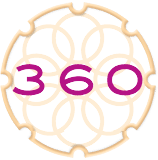Jaw Pain - (TMJ/TMD)
Presenting symptoms
A 40 year-old male came to 360 NMT to address his chronic headaches and jaw pain. Because he had a history of jaw clenching and teeth grinding (bruxism) at night, his dentist recommended a night guard to protect his teeth from further damage. He described his headaches as beginning on the back of his head (occiput) and traveling in an arc around to the temple, mostly on the left side.
Evaluation, clinical reasoning & treatment strategizing
Temporomandibular Joint pain is considered to have many contributing myofascial factors. If pain continues after traditional dental bit splint therapy has been applied a neuromuscular treatment plan can be very important to address pain and dysfunction.
360 NMT always checks for postural aberrations that adversely contribute to TMJ. Forward head position can strongly increase tension within jaw muscles. When the chin juts forward this puts stretch tension on the structures on the front of the neck. The natural action would be an open-mouth posture. In order to keep the jaw closed the jaw closing muscles end up firing continuously. This type of low-grade, isometric contraction is fertile ground for trigger point development. In this patient we indeed observed a forward head posture so our treatment plan considered not only treating the pain locally but to also addressing the postural dysfunction..
Treatment
Trigger points found in external masseter and temporalis muscles reproduced the headache symptoms. 360 NMT’s signature intra-oral techniques were used to release lateral and medial pterygoid muscles. NMT was applied to the distal anterior neck, especially the sternocleidomastoid, which can refer pain into the temple region and above the eye. Upper body postural dysfunction was improved by lengthening the tight pectorals and posterior sub-occipital muscles. NMT also helped to reduce tension in the posterior cervical muscles, and improve strength in the deep neck flexors.
Outcomes and follow-up
After four treatments, the headaches had abated. Instructions were given for intra-oral, self-care treatment. Recommendations were made for upper back and intra-scapular strengthening to maintain correct posture. The patient continues to wear his night guard.
